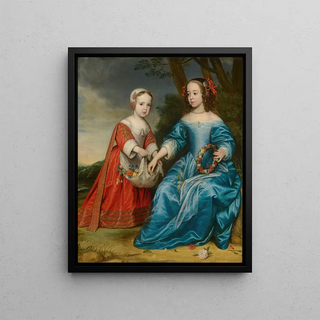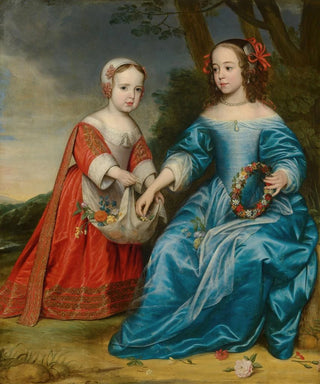Art print | Double portrait of Prince William III (1650-1702) and his aunt Mary, Princess of Orange (1642-1688), children - Gerard van Honthorst


View from behind

Frame (optional)
Gerard van Honthorst's art print, "Double portrait of Prince William III and his aunt Mary, Princess of Orange," immerses us in a world where nobility and art meet with rare intensity. This painting, which immortalizes two emblematic figures of 17th-century Dutch history, exudes an atmosphere of tenderness and dignity. Through exchanged glances and delicate gestures, Honthorst succeeds in capturing not only the physical appearance of his subjects but also the essence of their familial relationships. This work resonates as an echo of the values of the era, where status and representation were intimately linked to social perception.
Style and uniqueness of the work
Honthorst's style is distinguished by his masterful use of light and shadow, a technique known as chiaroscuro. In this double portrait, the children's faces are illuminated in a way that accentuates their delicate features and innocent expressions. The color palette, both soft and rich, creates a striking contrast between the ornate clothing of the characters and the darker background that surrounds them. This approach gives the art print emotional depth, allowing the viewer to feel the closeness and affection that unite William and Mary. The meticulous details, from the embroidery on their garments to the carefully chosen accessories, demonstrate a particular attention to the representation of nobility, while also evoking touching intimacy.
The artist and his influence
Gerard van Honthorst, born in Utrecht in 1592, is one of the masters of Dutch Baroque. Trained in Italy, he was influenced by the great masters of painting, notably Caravaggio. His return to the Netherlands marked the beginning of a prolific career, where he skillfully combined Italian techniques with Dutch themes and aesthetics. Honthorst is renowned for his portraits, but also for his genre scenes and religious compositions. His ability to capture light and create intimate atmospheres has inspired many artists.

Matte finish

View from behind

Frame (optional)
Gerard van Honthorst's art print, "Double portrait of Prince William III and his aunt Mary, Princess of Orange," immerses us in a world where nobility and art meet with rare intensity. This painting, which immortalizes two emblematic figures of 17th-century Dutch history, exudes an atmosphere of tenderness and dignity. Through exchanged glances and delicate gestures, Honthorst succeeds in capturing not only the physical appearance of his subjects but also the essence of their familial relationships. This work resonates as an echo of the values of the era, where status and representation were intimately linked to social perception.
Style and uniqueness of the work
Honthorst's style is distinguished by his masterful use of light and shadow, a technique known as chiaroscuro. In this double portrait, the children's faces are illuminated in a way that accentuates their delicate features and innocent expressions. The color palette, both soft and rich, creates a striking contrast between the ornate clothing of the characters and the darker background that surrounds them. This approach gives the art print emotional depth, allowing the viewer to feel the closeness and affection that unite William and Mary. The meticulous details, from the embroidery on their garments to the carefully chosen accessories, demonstrate a particular attention to the representation of nobility, while also evoking touching intimacy.
The artist and his influence
Gerard van Honthorst, born in Utrecht in 1592, is one of the masters of Dutch Baroque. Trained in Italy, he was influenced by the great masters of painting, notably Caravaggio. His return to the Netherlands marked the beginning of a prolific career, where he skillfully combined Italian techniques with Dutch themes and aesthetics. Honthorst is renowned for his portraits, but also for his genre scenes and religious compositions. His ability to capture light and create intimate atmospheres has inspired many artists.






